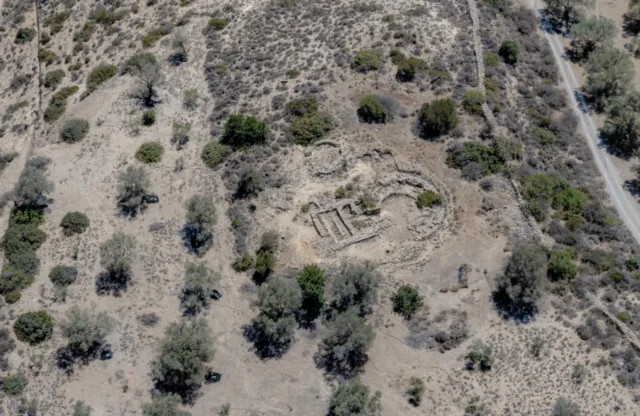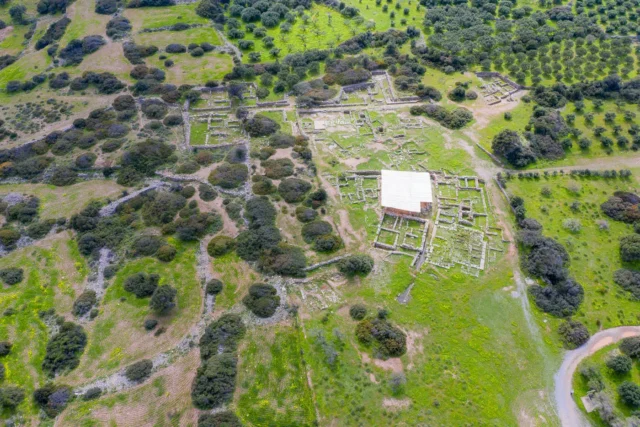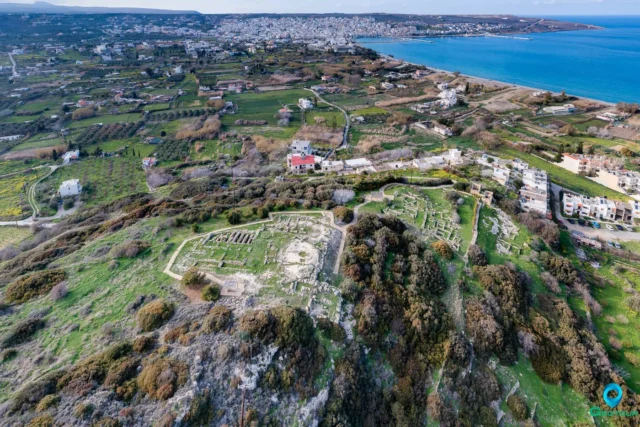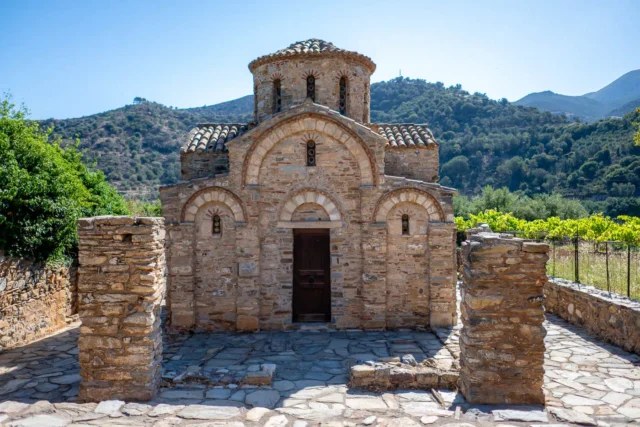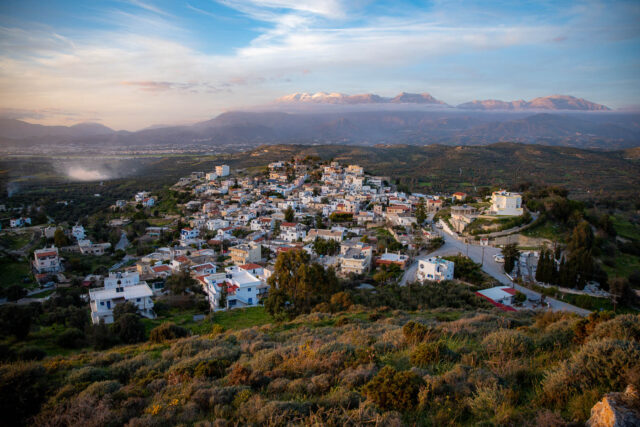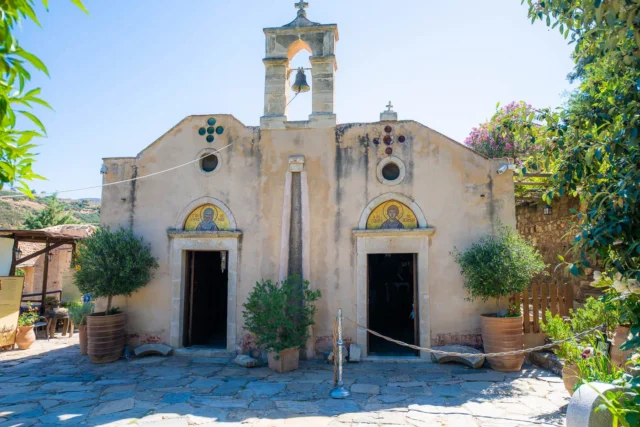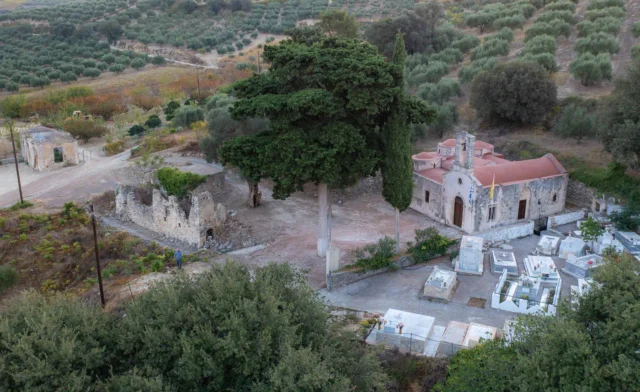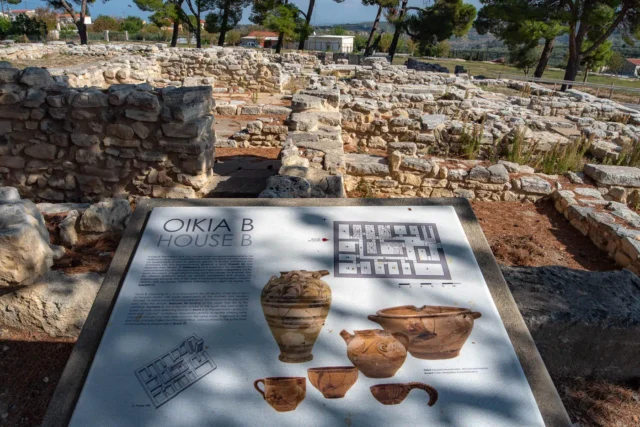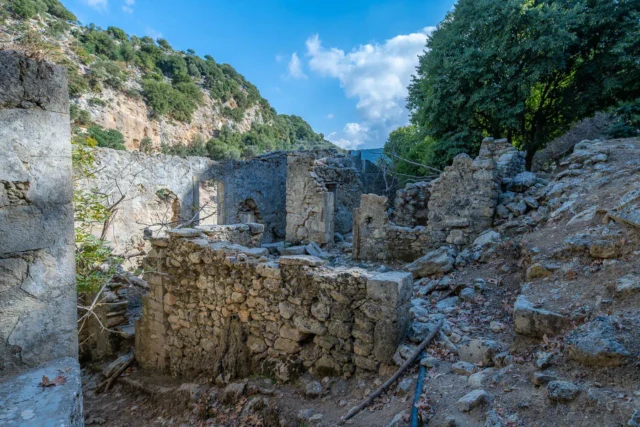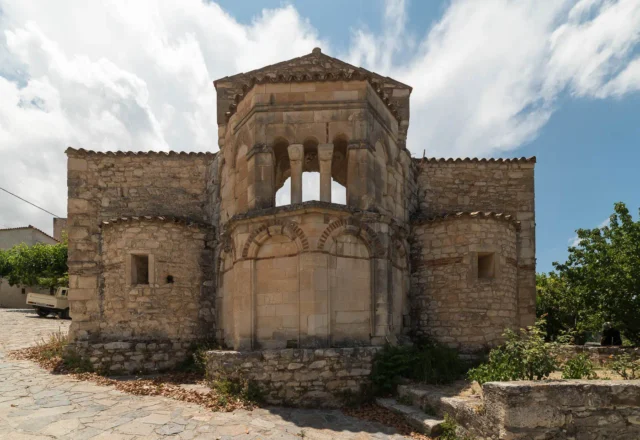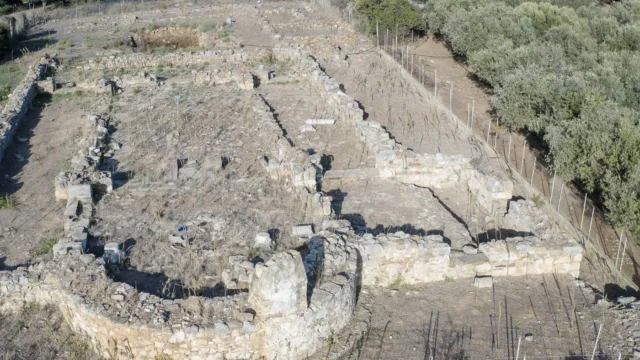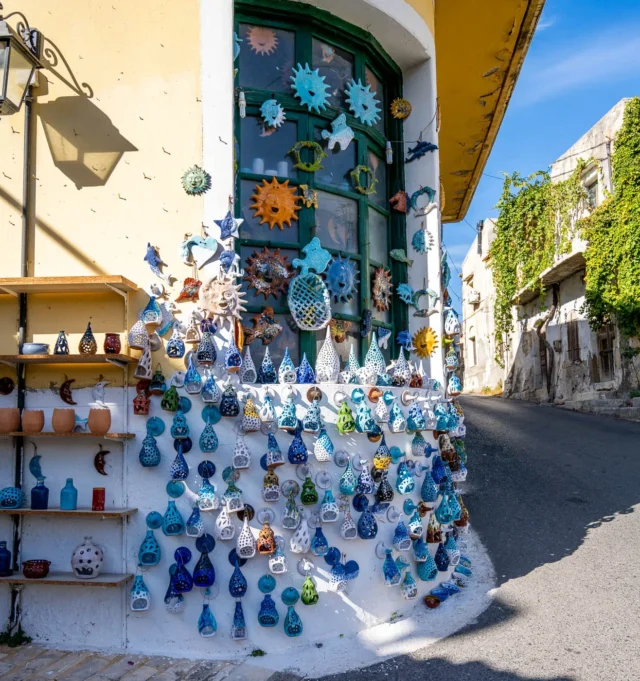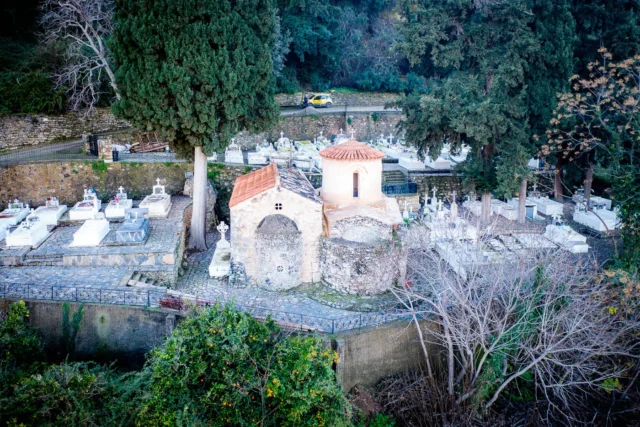829
listings found
Categories
Active filters:
Minoan Archaeological Site at Odigitria Monastery
The Odigitria Cemetery in Crete's Asterousia mountains is an archaeological site dating back to the Early Minoan (EM) period.
It features two tholos tombs (A and B), a Rectangular Building, courtyards, an ossuary, and a possible altar, all enclosed within a peribolos wall. The site's three construction phases span from the Final Neolithic to the Middle Minoan (MM) era. Tholos A, the smaller of the two tombs, contained undisturbed EM I pottery, while Tholos B boasts a unique complete outer wall. The Rectangular Building may have served as an independent burial building or ritual space. The courtyards, particularly the Eastern and Outer Courtyards, likely hosted rituals associated with the deceased. The ossuary reveals the practice of secondary burial, where bodies were initially interred in the tholos tombs or pithoi and later transferred to the ossuary. The Odigitria Cemetery provides significant insights into Early and Middle Minoan burial practices, social structures, and material culture.
Apesokari Tholos tombs
The Apesokari Tholos Tombs in Crete are significant Early Minoan burial sites. Tholos Tomb A features a unique circular burial chamber and annex, used for both primary and secondary burials. Tholos Tomb B includes multiple rooms with evidence of communal drinking and larnax burials. Both tombs offer valuable insights into Early Minoan funerary practices and social organization.
Palaikastro Minoan Settlement (Roussolakkos)
The Minoan settlement of Palaikastro, located near the modern village of Palaikastro on Crete's eastern coast, thrived during the Bronze Age. Occupied from the Early Minoan II to the Late Minoan IIIB periods (c. 2600-1200 BC), the settlement spanned over 50,000 square meters. Palaikastro's strategic location with a sheltered harbor facilitated trade and agriculture. Excavations have revealed a well-planned town with houses, workshops, and evidence of a vibrant social and economic life. The town's layout suggests central planning, with grid-like streets and organized blocks of houses, possibly indicating a clan-based social structure. Palaikastro's economy was based on agriculture, trade, and crafts like weaving, metalworking, and pottery production. Religious practices are evident through artifacts like figurines and incense burners. Ongoing archaeological investigations continue to enrich our understanding of this important Minoan center.
Petras Minoan settlement
Located near Siteia in eastern Crete, this significant Minoan archaeological site shows continuous occupation from Final Neolithic (ca. 4000 BCE) to Byzantine eras. Excavations reveal a small palace, first built in MM IIA, destroyed around 1700 BCE (MM IIB), rebuilt in Neopalatial (MM III-LM IB), and destroyed again in LM IB. Features include a central court, magazines, ashlar masonry, and the best-preserved Minoan hieroglyphic archive. A few Linear A inscriptions were also found. The palace was the center of an urban settlement with houses, evidence of pottery, textile, and purple dye production, and Protopalatial/LM III fortifications. Limited Postpalatial (LM III) reoccupation occurred. The site offers key insights into Minoan regional administration and economy in eastern Crete.
Zakros Minoan Palace
The Minoan Palace of Zakros, situated in eastern Crete, features Neolithic habitation and a significant Late Minoan IB palace. Excavations reveal a Neopalatial settlement, Protopalatial houses, and evidence of post-palatial reoccupation. The palace, with 150 rooms and a central court, highlights Minoan architectural conventions. Discoveries include clay nodules, seal impressions, and elaborate artifacts like the "Bull’s Head Rhyton." The site’s history spans from the Final Neolithic to the Late Minoan IIIB periods, marked by both construction and destruction, potentially by natural disasters. Excavations by Hogarth and Platon uncovered residential and economic zones, a complex street network, and palatial annexes. The site, lacking modern visitor facilities, offers insights into Minoan civilization, with artifacts exhibited in Heraklion, Aghios Nikolaos, and Siteia museums.
Knossos archaeological site
The Palace of Knossos, located on the Kephala hill south of Heraklion, Crete, is an important site of the ancient Minoan civilization. Occupied since around 7000 BCE during the Aceramic Neolithic period. The First Palace, built during the Middle Minoan IB-IIA period, represents a significant shift in Minoan society from a clan-based structure to a hierarchical one. This monumental building, covering nearly 10,000 square meters on the ground floor alone, served as a hub for administrative, storage, and cult activities. The First Palace also introduced innovative features like storage magazines, showcasing the society's wealth and resources. The New Palace emerged after a massive earthquake that occurred at the end of the Middle Minoan IIIA period, the palace underwent major reconstruction in the Middle Minoan IIIB period. Around 1450 BCE, widespread destruction occurred across Crete, affecting palaces and settlements. While Knossos suffered damage, it wasn't destroyed like other palaces. This period saw the introduction of Linear B, an early form of Greek script used by the Mycenaeans, suggesting their presence at Knossos. The final destruction of the palace, possibly in Late Minoan IIIA2 (1325-1300 BCE), left it deserted, but the town continued to exist. Knossos continued to be inhabited during the Classical, Hellenistic and Roman periods. Two basilicas from the First Byzantine period indicate that the city was still active during this time. Knossos appears to have followed the fate of other urban centers in Crete and declined early.
Malia Minoan Palace
The Minoan archaeological site at Malia, located on the northern coast of Crete, is a significant site for understanding the Bronze Age civilization. The Palace of Malia is the third largest Minoan palace discovered. The palace and surrounding town and cemeteries offer a glimpse into the complex social, political, economic, and religious structures of Minoan society. The area was inhabited as early as the Early Neolithic period. The first monumental architecture at Malia, often referred to as the Old Palace, dates to the Early Minoan IIB period. This structure, or group of structures, was built around a large open space, sharing the same alignment as the later palace. The second palace, whose ruins are visible today, was built in the Late Minoan IA period, around 1650 BCE. It was constructed on the ruins of the Old Palace, inheriting its basic layout and orientation. The palace's central court, a defining feature of Minoan architecture, is oriented north-south. The New Palace at Malia met its demise around 1450 BCE, coinciding with the destruction of other Minoan sites across Crete. The cause of this widespread destruction remains a topic of scholarly debate.
Panagia ton Angelon in Fradio
Panagia ton Angelon, a 15th-century Catholic church in Fradio, Crete. Gothic influences and monastery ruins mark this historic site.
Museum of Domenikos Theotokopoulos (El Greco)
The Museum of Domenikos Theotokopoulos (El Greco), situated in the village of Fodele, Crete, serves as a tribute to the renowned artist’s formative years and artistic legacy. Established in 1998, […]
Church of Panagia (The Virgin Mary)
The Church of Panagia (The Virgin Mary) is located in the village of Fodele, Crete, on the site of a ruined 7th-century three-aisled basilica. The current church dates to the […]
Kamilari, Phaistos
Kamilari is a village in the Asterousia mountains of Crete. Its history dates back to the Minoan era. The village's name, first recorded in 1370, is likely derived from the Byzantine family name "Kamelaris" or the term "Hamilon Oros," meaning "Low Mountain."
Kamilari is archaeologically significant, with nearby sites like the Minoan palace of Phaistos and the Kamilari Tholos Tomb. The discovery of a bothros containing terracotta figures from the Geometric period confirms the area's long history of human presence.
The village's Cultural Association works to preserve local traditions and customs. Kamilari offers a unique experience for visitors to Crete.
Agios Panteleimon monastery in Fodele
Located in Fodele, 25 km from Heraklion, this Greek Orthodox monastery dates to the early Ottoman period, possibly after 1539. Its fortress-like architecture combines Byzantine and Venetian styles. It served as a rebel shelter during Cretan uprisings against the Ottoman Empire, notably the 1866-1869 revolt under Abbot Neophytos Pediotis. Largely demolished in 1972, its legacy was preserved by Archimandrite Meletios Apostolakis, with restoration starting in 2004. The two-aisled basilica houses 14th- and 17th-century icons.
Panagia Kera Eleoussa in Kitharida
Panagia Kera Eleoussa in Kitharida, near Heraklion, Crete, is a striking example of Byzantine ecclesiastical architecture. Serving as the katholikon of the Panagia Eleoussa monastery from the 11th century (with 12th/13th-century narthex and 15th-century reconstruction), it operated through Venetian and Ottoman periods. The church comprises three domed aisles dedicated to Agios Charalampos, the Dormition of the Theotokos, and Agios Fanourios. The unusual apses face north, and its exterior displays circular plaques with paintings, including a notable Spanish plaque with "Ave Maria gratia plena." Today, it remains alongside ruined cells and a roofless school (1841-1866)
Ancient Tylissos
Tylissos, an ancient Minoan town located on the slopes of Mount Psiloritis in Crete, thrived between 1650 and 1200 BC. The town's strategic location on a major Minoan road contributed to its prosperity. Excavations have revealed three grand palaces (Megaron A, B, and C), showcasing remarkable Minoan architecture. Megaron A, the best-preserved, features a central courtyard, apartments, and storage rooms.
Significant finds include bronze cauldrons, a bronze figurine, Linear A tablets, and miniature frescoes comparable to those found in Knossos. These discoveries suggest Tylissos was a center for bronze working and played an important role in the Minoan civilization. Numerous tombs dating back to 1400-1200 BC have also been unearthed, containing painted sarcophagi, vases, jewelry, and seals, offering further insights into Minoan burial practices and culture.
Panagia in Patsos
Located in Patsos, Amari, this ruined 14th-century church is a significant Byzantine monument in Rethymno. Its unique cross-in-square architecture blends Byzantine and Western elements, a style uncommon for the Cretan countryside. The interior was adorned with high-quality frescoes, considered fine examples of late Byzantine art, depicting the Virgin Mary, Saint Nicholas, and the Communion of the Apostles. Though damaged by an earthquake, its surviving elements attest to the cultural flourishing of Crete during this period.
Mouses abandoned village
Mouses, an abandoned village near Mourtzana in Rethymno, Crete, reflects the island's rural past. The village's history likely mirrored other Cretan settlements, with population fluctuations due to historical events and economic shifts. Abandoned watermills highlight Mouses's role as a center for milling grain in the pre-industrial era, crucial for producing flour and other grain-based products. The village's current state reflects the rural depopulation seen in Crete during the 20th century. Mouses stands as a testament to the passage of time, with its abandoned watermills offering a glimpse into traditional practices. Although no longer inhabited, Mouses retains historical significance, providing a resource for understanding Crete's rural past.
Agios Ioannis in Episkopi of Rethymno
Explore the ruins of the Agios Ioannis in Episkopi of Reethymno in Crete, a testament to the island's rich religious and historical heritage.
Margarites, Mylopotamos
Margarites, a historic village nestled in the mountains of Crete, is renowned for its rich pottery tradition that dates back to the Minoan era.
With a population of around 300, the village has seen its share of historical changes, from ancient Minoan and Roman times to the Venetian and Ottoman rule. Today, Margarites is a thriving hub for pottery production, with numerous workshops and studios showcasing the craftsmanship of its artisans. Visitors can witness pottery-making demonstrations, participate in workshops, and even create their own pieces. The village's pottery reflects influences from Minoan, ancient Greek, Byzantine, and Venetian periods. Margarites offers a unique blend of history, culture, and craftsmanship, making it a captivating destination for those seeking to explore the heart of Cretan traditions.
Temple of Sotiras Christos (Christ the Savior)
The Temple of Sotiras Christos in Eleutherna, Crete, is a dual-church complex with a rich history spanning from the Byzantine to the Venetian eras.









